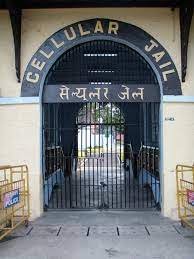Dhrubesh Chattopadhyay, a prominent figure in the Indian freedom struggle, hails from a family with a rich intellectual heritage. His unwavering commitment to India’s independence and his sacrifices have left an indelible mark on history. Born in Calcutta in 1904, Dhrubesh Chattopadhyay’s journey from his ancestral home to the notorious Cellular Jail in the Andamans is a story of courage, resilience, and dedication.

Postal Stamp in memory of Dhrubesh Chattopadhyay
Early Life and Influences
Dhrubesh Chattopadhyay was born into a distinguished family in Calcutta. His grandfather, Madhabchandra Chattopadhyay, was the author of “Bishuddha Sidhanta Panjika,” the most esteemed Bengali almanac. After the untimely demise of his parents, young Dhrubesh moved to his uncle’s house in Uttarpara, Hooghly, where he received his school and college education. This move proved to be pivotal, as Uttarpara’s vibrant intellectual and revolutionary atmosphere profoundly influenced his political consciousness.
Joining the Freedom Struggle
Dhrubesh’s involvement in the freedom movement began with his association with Amarendranath Chattopadhyay’s Uttarpara Swadeshi Yuba Samiti. Through this group, he came into contact with the revolutionaries from Chittagong who frequently visited Uttarpara from 1922-23. Inspired by their fervor and dedication, Dhrubesh began visiting their hideout in Dakshineshwar and actively participated in their activities.
In a significant act of commitment, Dhrubesh contributed his entire savings, which were intended for his sister’s marriage, to finance the manufacturing of bombs in Dakshineshwar. This act underscored his dedication to the cause of independence, placing the nation’s freedom above personal obligations.
Arrest and Imprisonment
On November 10, 1925, Dhrubesh Chattopadhyay’s revolutionary activities led to his arrest during a police raid at the Dakshineshwar hideout. The police discovered arms, chemicals, and unlawful documents, resulting in his detention. During the trial, Dhrubesh, along with nine others, was sentenced to seven years of rigorous imprisonment.
While imprisoned in Alipore Jail, Dhrubesh’s revolutionary zeal remained undiminished. He became involved in the assassination of Special Superintendent of Police and leading British spy Bhupen Chatterjee, which resulted in a further sentence of life imprisonment along with three other inmates. His transfer to Mandalay prison and subsequently to the Cellular Jail in 1933 placed him in the midst of a hunger strike agitation by the inmates, showcasing his relentless spirit and resistance against oppressive conditions.
Life in Cellular Jail
The Cellular Jail, known as “Kala Pani,” was infamous for its harsh conditions and brutal treatment of political prisoners. Despite the severe hardships, Dhrubesh Chattopadhyay’s resolve remained unbroken. The jail became a crucible where his commitment to India’s freedom was tested repeatedly. The camaraderie among the inmates and their shared struggles against the colonial regime provided Dhrubesh with the strength to endure the inhumane conditions.

The British Jail administration took special care to ensure that very few prisoners could go home. Malnutrition, disease, unhygienic conditions, and above all, hard manual work made sure most prisoners died there or became too weak to ever take part in the freedom movement again. Dhrubesh Chattopadhyay was a victim of this systematic British campaign to weaken revolutionary fire. Though he survived the ordeal, his health became fragile.
Hunger Strike and Release
The heroic Andaman prisoners started an indefinite hunger strike against this inhuman treatment on July 25, 1937. The news of their hunger strike reached Bengal and immediately stoked a huge fire of unrest. Despite his ill health, Rabindranath Tagore led the movement in support of Andaman prisoners, and Gandhi also joined the movement to bring back Andaman prisoners.
After 37 days of hunger strike, the British had to accept defeat and agreed to bring back the prisoners to more humane conditions in mainland jails.
Dhrubesh was eventually released in 1937, but the years of harsh treatment had taken a severe toll on his health. Suffering from fragile health and tuberculosis, he struggled to regain his strength and resume active organizational work.
Post-Release Activities
Despite his deteriorating health, Dhrubesh Chattopadhyay continued to contribute to the freedom movement. He participated in the Uttarpara Hadcol (Bone Meal Factory) workers’ struggle alongside Manoranjan Hazra and organized a farmers’ movement in Makhla Bonder Bill. His unwavering spirit and commitment to social justice remained evident, even as his physical condition worsened.
Legacy and Remembrance
Dhrubesh Chattopadhyay passed away on April 15, 1938, at the young age of 34. His life and sacrifices are remembered with great respect and admiration. His story is a testament to the indomitable spirit of those who fought for India’s independence. In Uttarpara, his legacy is honored through various commemorative events and educational initiatives. Schools and community organizations regularly hold programs to educate the younger generations about the sacrifices made by Dhrubesh and other freedom fighters.
His association with Amarendranath Chattopadhyay’s Uttarpara Swadeshi Yuba Samiti and his daring involvement with the Chittagong revolutionaries highlight his crucial role in the broader narrative of India’s struggle for freedom. Dhrubesh’s life story serves as a powerful reminder of the importance of courage, determination, and the relentless pursuit of justice.
Conclusion
Dhrubesh Chattopadhyay’s life is a poignant reminder of the sacrifices made by countless individuals in the fight for India’s independence. His journey from a young boy in Calcutta to a revolutionary in the Cellular Jail encapsulates the essence of the freedom struggle. As we remember Dhrubesh Chattopadhyay, we honor not only his legacy but also the collective struggle of all those who fought for India’s freedom. His story continues to inspire and remind us of the importance of standing up against oppression and fighting for justice, even in the face of seemingly insurmountable challenges.
More Information: Dhrubesh Charan Chatterjee




